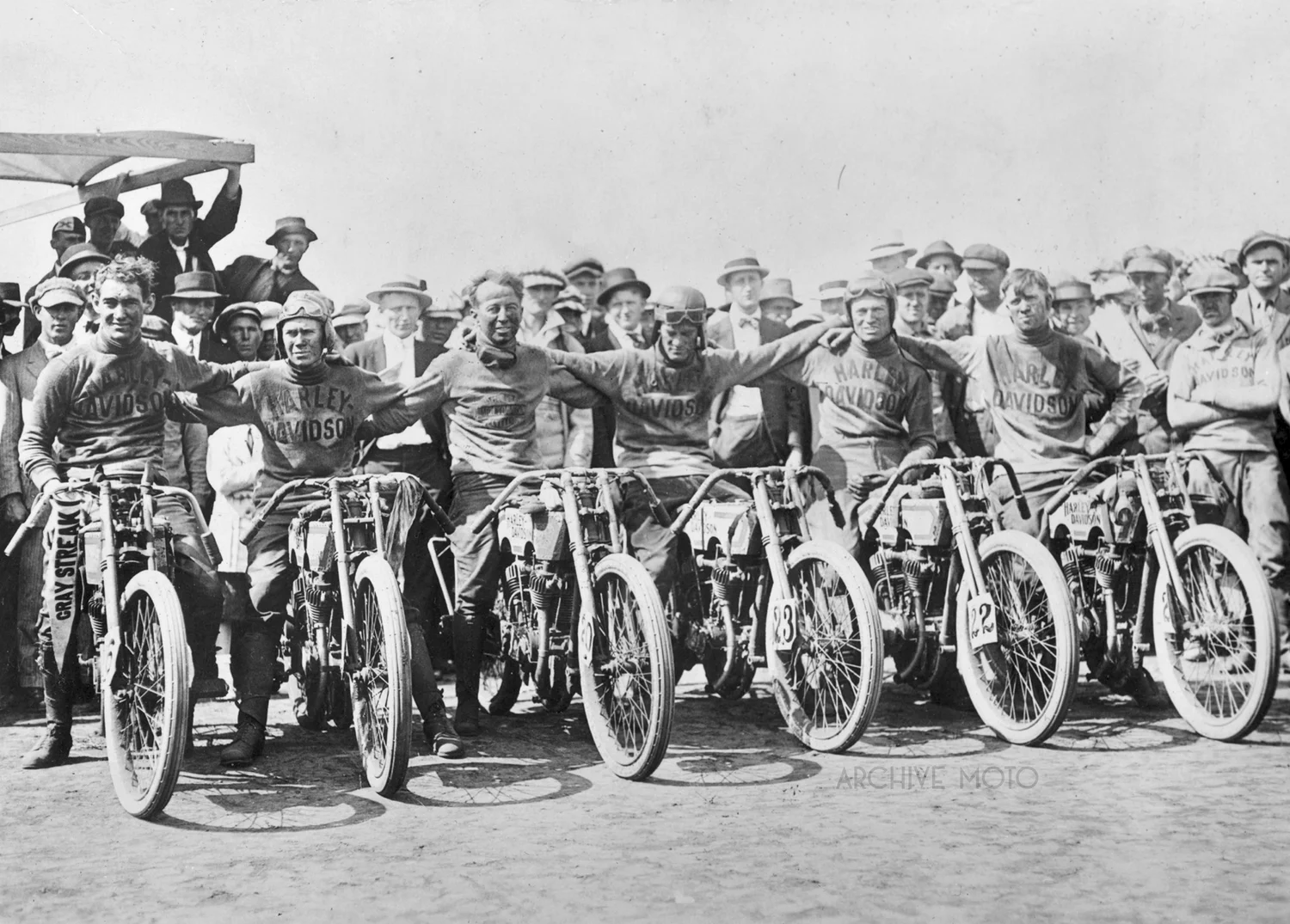Eugene Walker, loving known as Gene is one of the South’s most beloved motorcycle racing pioneers. Born in the small town of Plevna, AL, just south of the Tennessee line, Gene grew up in Birmingham after his mother moved the family following the tragic murder of his father just months before his birth. Like many of America’s earliest racing stars, Gene took to motorcycling early in life, climbing on board his first machine around 1910. The story goes that he honed his riding skills as one of Birmingham’s first motorcycle postman, whirling around the city delivering mail in record time no doubt. Despite his later success as a professional racer, Walker also maintained a position on the Birmingham Police Department’s motorcycle squadron throughout his life, a fact that surely inspired hesitance in any would be wrongdoer in the city.
By 1912 the racing bug had landed upon Gene’s shoulder and being that Birmingham was one of the southern capitals of motorcycle racing, he quickly found his place. That same year Walker captured his first amateur win in the 5-mile event at the Birmingham Fairgrounds, catching the eye of local Indian distributor and one of Indian’s first factory racers Robert Stubbs. Bob as he was known, was a legend in his own right having made his start racing bicycles in the late 1800’s. By 1907 Stubbs was a cornerstone in the motorcycle culture of Birmingham. Stubbs had been racing professionally for Indian since at least 1909 and took young Walker under his wing. With Stubbs' guidance, Walker began dominating the events he ran on board his mentor's Indians, overtaking seasoned pros like Arthur Mitchell, Joe Wolters, and Charlie Balke… he was still an amateur. Walker then turned pro in October of 1914, and in July of 1915 he had officially signed with the factory team at Indian and claimed his first national victory in Saratoga, NY. The war years sent Walker a adrift, first returning home to Birmingham where he worked at a local Harley dealership. During that time he entered local races a privateer onboard Harley’s before returning to Springfield in 1918 to work in the factory and test new prototype machines. When professional racing resumed in America in 1919, Walker with the might of Indian was poised to dominate. Postwar professional motorcycle racing in America was a continuous battle between the now mighty Harley Davidson factory team, Bill Ottoway's legendary "Wrecking Crew” and the burgundy gentlemen of the WigWam, but Walker gave the Milwaukee boys a hard run for their money claiming 6 national wins for Indian in 1919 alone.
It was in April of 1920 when this photo was taken of Gene onboard his factory 61ci Powerplus Indian near the dunes of Ormond Beach. Walker had been sent to the famous speed coast along with fellow Birmingham racer Herbert McBride to make runs at several land speed records. The Birmingham boys proceeded to then smash 24 national and international speed records. In fact, Walker preformed so well onboard his newly configured side valve machine, with its distinctive finned exhaust ports seen in this photo, that the setup became known as the “Daytona” motor, a legend among American racing machines. Of the records, Walker claimed the first international FICM record at 104.12 mph, and hit 115.79 mph onboard his 61ci 8 valve racer. Following his exemplary showing in Florida, Walker continued to race and win for Indian. In an unfortunate circumstance regarding Walker’s refusal to run at the 1921 Dodge City race due to safety concerns, the brass at Indian released Walker from his contract despite protest from their own racing team. 1922, 1923, and 1924 were tumultuous years for Walker as he bounced between running for Indian and Harley, though victory never seemed too far out of reach regardless of factory politics. Tragically, in the midst of such instability Walker’s racing days came to an end on June 7, 1924 when during practice laps at Stroudburg, PA Walker collided with a tractor that had made its way onto the track under the cover of the dust kicked up. The 31 year old racer later succumbed to his injuries on June 21st, leaving behind his pregnant wife, his two daughters, and a legacy as one of the kindest and fastest the sport has ever known.
Sidenote: My good friend David Morrill has a wonderful article detailing the life and times of young Gene Walker on his site dlmracing.blogspot.com that encourage everyone to check out.
Here is one directly from the pages of Georgia Motorcycle History, available now just CLICK HERE.
Motorcycle competition has taken many forms since the first two machines were pitted against one another at the turn of the 20th century. From the modern, on-the-edge action of MotoGP to the near vertical hill climbs of the 1930's. From the multi-day endurance events to the lightening fast drag strips. The beach races, flat tracks, salt flats, massive super speedways, nail bitting TT races, horse track sprints, and the thrilling dashes over the wooden slivers of the American motordromes, it is remarkable how the sport has evolved and varied in the one hundred some-odd years since its inception. But among all of the legends, icons, and fallen heroes that dedicated their life to rocketing around the varied venues of the sport, each one had to start somewhere.
In the beginning it was the local motorcycle clubs, the brotherly band of enthusiasts that bolstered a rapidly expanding professional industry by organizing and promoting events for young aspiring demons to test their skill against one another at local horse tracks and on the small backroads of America. Here, four men, and four different makes of machine, a Pope, an Excelsior, an Indian, and a Harley-Davidson take to the line for a small-town road race in Tebeauville, modern day Waycross, Georgia in southwest of the state, sometime in the mid-teens. Who do you think won?
Read more about the early evolution of motorcycle racing in the pages of Georgia Motorcycle History: The First 60 Years 1899-1959, get you copy today HERE
Today's post is an open question to the community. Another forum find, I recently stumbled upon this little gem. It is credited in Rin Tananka's Harley Davidson Book of Fashions as August Walters (August E. "Blick" Wolters) onboard a single cylinder Harley-Davidson racer at the Legion Ascot Speedway, January 8, 1927. However, that is no ordinary, run of the mill factory Peashooter of late 1920's acclaim. It is a blanked-off Cyclone twin in a keystone frame with what appears to be a Merkel fork, a real (fast) frankenstein. So who was August Walters and where did he come across such a wonderful abomination. Was the machine created by Walters, and how did it stack up against legends like Joe Petrali riding the latest overhead valve Harley Davidson factory singles, affectionately known as Peashooters? I welcome any and all information and speculation friends.
UPDATE: Since posting this request for information earlier today those treasured and seemingly all knowing enthusiasts that occupy the web have piped up and filled this machine's truly remarkable pedigree. August E. “Blick” Wolters was indeed a privateer racer in the late 1920’s and manufactured this odd bird on his own. Unable to acquire a factory single “peashooter" from either Harley-Davidson or Indian, Wolters retooled his Cyclone twin by removing the rear cylinder, machining a new barrel and domed piston, and retrofitting an oil pump off of an Indian to the former rear cylinder’s overhead camshaft. Wolters himself was quite the character, having run Henderson’s in Los Angeles area events as far back as 1916. Most notably, Wolters set a new record in March of 1918 by piloting his Henderson 4 up the 9-mile toll road up Mt. Wilson. He covered the distance in 26 minutes 24 seconds despite having a spill halfway up the mountain which rendered his clutch useless and permanently retarded his spark advance. Wolters again made the headlines a few weeks later when he took another Henderson 4 for a couple of laps over the tracks of LA’s largest roller coaster… but I digress. After reconfiguring and down-engineering his powerful Cyclone engine Wolters then squeezed the now single-cylinder power plant into a mid 20’s short coupled Harley Davidson frame, he also added a rigid Flying Merkel fork, a popular front end among speed demons. Thus the machine that a smiling Blick Wolters poses with in this photo from the January 1926 races at the Legion Ascot Speedway was born, but the story does not end there. Wolters continued racing the machine, until it ultimately became a part of the collection at Harrah’s Automotive Museum in Reno, Nevada where it remained for some time. The machine was then restored and the Cyclone engine put back to its original, factory configuration. In the early 1980’s the Harrah’s collection was sold and the machine changed hands between collectors a handful of times in recent decades. In 2012 this odd racer, made by the hands of August E. Blick Wolters was stolen in an unnerving armed home invasion, the machine remains missing.
Thank you everyone who helped fill me in on this amazing story.
How many times have you seen this picture? How much do you know about it? How about a little background on one of the most reposted and iconic images in motoculture?
In February of 1921 Otto Walker, one of the original members of Harley Davidson's legendary Wrecking Crew threw his leg over a state of the art banjo 2 cam 8-valve factory racer and became the first man to win a race at an average speed of over 100 mph on the boards of the Fresno Speedway.
The image is used most often as the quintessential representation of board track racing, however by the 1920's the tight, steeply-banked circular motordromes had all disappeared. Although the 1-mile long Fresno Speedway was surfaced in the same manner as the early circular motordromes, it was oval in shape with flat straightaways and banked corners, as was the standard construction style after WWI. The last of the circular dromes was built 7 years prior in 1914, and the sanctioning body in America, the M&ATA had outlawed races on any tracks less than 1 mile in length in 1919.
Otto piloted his two-wheeled rocket to just over 107 mph in the 1-mile time trail, and won the 50-mile at just over 101 mph. Walker also earned the title of winning the most races at a single event that same day, sweeping all categories at over 100 mph each. One odd detail, after serving as an aeronautic mechanic in France during the Great War Walker acquired a rather unique crested German pilots helmet which he debuted upon his return to professional racing in 1919. In what is arguably one of the most iconic images in motorcycling history Walker's signature helmet is missing, Id like to think for aerodynamic purposes.





